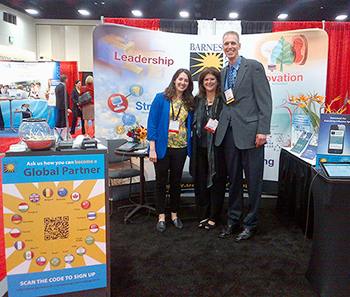
The Barnes & Conti Newsletter:
March 2014

Be An Effective Agent of Change
From Skills to Results
Any consultant, internal or external, will be called upon to lead or manage change. Most organizations are relatively capable of maintaining the status quo on their own—often too capable. The reason for bringing in a consultant is usually because some process or structure has broken down, is not competitive, is slowing the work of the organization, or is no longer relevant. In short, the status quo no longer works. A problem must be solved, a solution must be implemented; changes or improvements must be made. Bring in the consultant!
As an internal consultant, your role may sometimes be to identify changes or solutions that are needed—but more often it will be to enable the implementation of changes or solutions that have been decided upon. The earlier you are involved in the process, however, the more influence you will have and the more likely your expertise will save the organization time, resources, or the consequences of uninformed decisions. If you can enter the process at the point where a problem or opportunity can be identified and dealt with proactively, your expertise can be of great value to your clients.
Regardless of whether you are an internal or external consultant, the organization will benefit from your ability to take an objective, curious, skeptical, and analytical approach to the complexity surrounding any major change. In other words, your “detective” skill-set will serve you well.
Solve your internal mystery today by employing the skill sets discussed in “The Influential Internal Consultant” white paper. Use this link to download.
The Influential Internal Consultant (excerpt)
B. Kim Barnes
... An internal consultant, regardless of his or her area of expertise, depends upon influence skills and organizational savvy in order to be effective. All consultants, whether internal or external, rely on expertise, influence, and personal skills to facilitate client-requested changes without having the formal authority to implement those changes alone.
The process of consulting, particularly for an internal consultant, generally proceeds through the following phases, and each phase poses an influence challenge to the internal consultant...
Read the “The Influential Internal Consultant”
It’s a Steal!
Public Program Special
Offer
Work on your personal skills and get a feel for how our programs could benefit your organizations by signing up for our Public Programs.

Click here for the 2014 Public Program Schedule
Our Global Partner: ASAS Training Center,
Saudi Arabia
2014 Training Industry Trends are Bringing Opportunities for Local Training Companies
Tawfiq Algargoush, General Manager, ASAS
Key training industry observers are saying that trends in 2014 are moving from generic, learner-centric training programs and shifting towards focused, customized business-centric development. Doug Harward, in this winter’s issue of Training Industry Magazine, notes this trend toward business-centric development. Previous practices “missed the mark on the most fundamental principle of success: ensuring that training is aligned to the needs of the business first.” The new focus needs to be on developing skills that impact overall business performance.
The Saudi training market is no exception to these international trends. Multi-national organizations capture the largest market share of the Saudi training industry—an estimated $2.6 billion with a 6% yearly growth rate...
 A Note from Our Trainers:
A Note from Our Trainers:
Dealing with a Difficult Classroom Participant... It May Be as Easy as Five C’s
Bette Krakau
Tackling a disgruntled, argumentative or overly critical participant can pose a challenge for even the most savvy and experienced facilitator. Dealing with difficult participants is a skill worth perfecting. It requires reflecting on “Why is this happening?” And “What are the options?” By focusing on the options, positive things can happen so that the Trainer, other participants, and the learning outcomes do not become victims of the situation. Conventional wisdom suggests that it’s not personal, so there is no need for the Trainer to take it personally.
Dealing with Difficult Participants starts with the Trainer and has five critical C’s—calm, cool, curious, candid and clear—to use for identifying the “why” and determining mutually satisfactory options for solving the problem.
Calm: The first move is the simplest, take a few deep breaths and exhale slowly. When calm and composed, the Trainer is able to be more objective.
Cool: Use neutral and non-judgmental voice, facial expressions, and body language when communicating with a Difficult Participant.
Curious: Maintain control by asking open-ended questions that help deepen understanding of the situation. Follow-up with active listening, checking for understanding, and clarifying issues.
Candid: Acknowledge the feelings that the participant has shared, and identify some options for dealing with their concerns.
Clear: Share openly with the participant any benefits to them for being fully engaged in the learning. Ask the participant for their support of the training and the other participants.
Good luck on your next training venture!
Updates from Barnes & Conti
Training 2014 Conference & Expo
 Training 2014 proved to be another great conference. As
always, it was good to see some old friends and meet many
new ones. We loved the “States of Being” theme: Be Happy, Be
Healthy, Be Human and Be Forthright. We added one more…#BeInfluential!
Training 2014 proved to be another great conference. As
always, it was good to see some old friends and meet many
new ones. We loved the “States of Being” theme: Be Happy, Be
Healthy, Be Human and Be Forthright. We added one more…#BeInfluential!
Many training facilitators and consultants stopped by our booth to try out a tablet version of our Influence Behavior Survey. We were all surprised and pleased by how quickly participants gained insight into their influence challenges and behaviors. In reviewing summary feedback, we heard responses that probably resonate for many of us:
- “I know I should do more listening in the work I do with my clients.”
- “While I ask a lot of open-ended questions, I need to draw out more before launching into my proposal.”
- “It’s sometimes hard for me to find meaningful incentives that don’t sound like reasons.”
- “I’m worried about damaging relationships when I describe consequences.”
- “Envisioning can be very powerful; I should use it more.”
- “My role as an internal consultant demands that I pose challenging questions.”
Contact us if you’re interested in more information about the Exercising Influence Behavior Assessment or to discuss how we might help you build your influence and consulting skills.
Our congratulations to all of the Best Practice and Top 125 winners. We want to give a special shout-out to Capital One and Novo Nordisk for making the Top 125 this year and to Verizon on being named to the Training Top 10 Hall of Fame!
Like our newsletter?
For more valuable information and special offers, follow us!
In this Issue:
- From Skills to Results
- Featured Article: “The Influential Internal Consultant”
- Public Program Special Offer
- 2014 Training Industry Trends are Bringing Opportunities for Local Training Companies
- Dealing with a Difficult Classroom Participant... It May Be as Easy as Five C’s
- Updates from Barnes & Conti: Training 2014 Conference & Expo
- Featured Recipe: Kofta
- Featured Art: “The School of Athens,” Raphael
Upcoming Open Enrollment Programs
Exercising Influence
- June 3, 2014, Philadelphia, PA
- June 19, 2014, Berkeley, CA
Consulting on the Inside
- June 4, 2014, Philadelphia, PA
- June 20, 2014, Berkeley, CA
Managing Innovation
- July 10, 2014, Berkeley, CA
See the full schedule on our website to register online
Also see our special offer at the left.
Recipe: Kofta—Middle Eastern Meatballs or Kebabs

Kofta—whether as pan-fried meatballs or grilled “kebabs” on skewers are popular throughout the Middle East. The seasoning varies from country to country and region to region.
The version below, in deference to our Global Partner in Saudi Arabia, is seasoned with spices familiar to that region. Although I use a mix of ground turkey and beef, all beef or all lamb is more traditional.
Ingredients:
- 1 1/4 lbs. ground meat (lamb, beef, chicken, turkey, or a combination)
- 1 very large onion, chopped
- 1/4 large bunch Italian parsley, leaves only
- 1/3 cup bread crumbs or gluten free flour mix (fried version only)
- 1 egg (fried version only)
- Small handful of mint leaves
- 1 tsp. cinnamon
- 1/4 tsp. ground black pepper
- 1/4 tsp. salt
Method:
- Put the coarsely chopped onion and stemmed parsley in a food processor. Pulse on the “chop” setting until finely minced.
- Mix onions, parsley, and seasonings well with the chopped meat.
- If you're going to fry the kofta, add the egg and bread crumbs or gluten-free flour. (You can also use cooked rice for gluten free). Mix well.
For Frying:
- Roll the mixture into meatballs about the size of ping-pong balls (or small patties like sliders).
- Heat plenty of olive oil in a skillet. Fry the kofta until browned on all sides and cooked through.
For Grilling/Broiling
- Mold the meat mixture over 6 inch or 8 inch skewers, leaving a “handle” of about 2 inches at the bottom.
- Grill or broil over a hot flame for about 4 minutes per side, until the kofta is browned and cooked through.
Serve with rice and/or pita bread. It’s nice to have a sauce with the kofta as well. A garlicky, lemony tahini sauce is very good, as is cucumber yogurt sauce (tzatziki is the Greek name), also made with garlic and lemon. You can precede the kofta with a selection of your favorite Middle Eastern salads and dips.
Serves 4 - 6
Did You Miss Us at Training 2014?

Visit us at Booth 1319 at ASTD and take the tablet version of our Influence Behavior Survey!
You are receiving these emails from Barnes & Conti because you are a client, colleague, and/or friend of Barnes & Conti Associates. Inc. or you contacted us through our website, at a trade show, or via social media. Barnes & Conti does not sell, trade, or give away mailing lists or email addresses to anyone. Period.
If you no longer wish to receive these bulletins, use this link to unsubscribe or write us at Barnes & Conti, 940 Dwight Way Suite 15, Berkeley, CA 94710.
*Please don't forward this entire email; the person you forward to might inadvertently unsubscribe you with the above link!